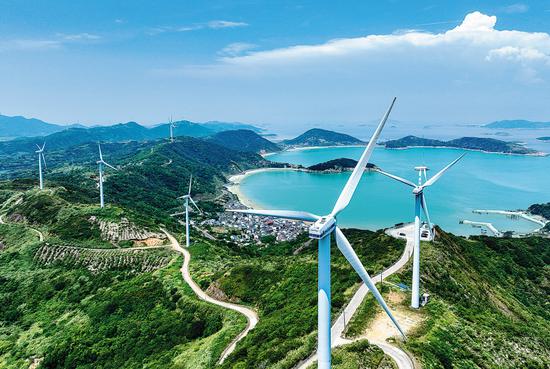Clean energy utilization helps in meeting green goals

A wind farm generates power for grids in Zhoushan, Zhejiang province. (Photo by YAO FENG/FOR CHINA DAILY)
Chinese businesses ought to hone their focus on optimizing fossil fuel efficiency, ramping up clean energy utilization and harnessing green financial instruments to slash financing expenses spent on low-carbon initiatives, amid the ongoing global wave of green transformation, said an executive.
These strategic moves, coupled with investments in green technology research and development, active engagement in carbon trading and a suite of other measures, are underscoring a concerted push toward achieving China's decarbonization goals, said Alex Zhu, APAC industrials and energy industry group co-leader at accounting firm EY.
The remarks were to address rising concerns among businesses on how to balance low-carbon development with profitability during their green transformations, and how to alleviate pressure from green investments and turn them into new growth opportunities.
Zhu emphasized the importance of businesses conducting a comprehensive assessment of their carbon assets and footprints to develop effective emission reduction plans. By strategically investing in areas with high-emissions but relatively low emission-reduction costs, businesses can maximize benefits.
"Furthermore, businesses should integrate emission reduction plans into their long-term development in an organized manner, focusing on improving fossil fuel efficiency, increasing clean energy usage and extending the industrial chain to achieve a gradual green transformation," Zhu said.
Growing global demand for environmental protection is propelling businesses to actively pursue green transformations. Many countries are now promoting carbon emission trading systems as a market-based mechanism to reduce greenhouse gas emissions through economic incentives, setting emission limits and allocating rights to companies for cost-effective emission reductions.
China has established the world's largest carbon market, with a comprehensive institutional framework in place. The country saw significant growth in carbon trading in 2023, indicating a maturing market with increasing demand for carbon trading, said a recent report by EY China.
In addition to carbon trading, some countries have begun implementing carbon taxes to curb excessive carbon emissions.
The Carbon Border Adjustment Mechanism was also introduced to price carbon emissions into the production of carbon-intensive products entering the European Union, thus promoting cleaner industrial practices. After a transitional phase, the CBAM will be fully implemented after 2034, posing challenges for enterprises exporting to the EU.
"Besides carbon offset methods, technological innovation is crucial for businesses to achieve core emission reductions. Meanwhile, businesses are advised to leverage green financial tools, invest in green technology R&D, and embrace sustainable practices like green energy and energy-efficient buildings to reduce emissions, lower energy costs and improve operational efficiency. Active participation in carbon trading can also provide additional income amidst the expanding carbon market and diverse emission reduction projects," Zhu said.

